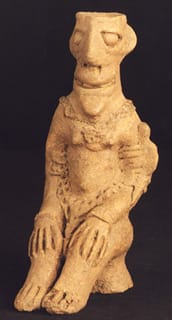Komaland Sculpture of a Seated Man, 12th Century CE - 16th Century CE
Terracotta
3.5 x 8.5
PF.1295
Komaland is located south of Burkina Faso border in Northern Ghana, in the valleys between Sisili and the Kulpawan rivers. The people of Komaland are mainly farmers, growing corn, millet,...
Komaland is located south of Burkina Faso border in Northern Ghana, in the valleys between Sisili and the Kulpawan rivers. The people of Komaland are mainly farmers, growing corn, millet, onions, tomatoes, and various types of nuts. Until 1985 very little was known about this mysterious culture. The previous 20 years farmers have found terracottas in the ground, but knew nothing of their history. Their value was soon recognized by scholars. In March and April of 1985 a permit was issued to excavate the Komaland site. Since then more information about this unique culture has filtered out.
The present-day village is built around and on numerous archaeological sites. Many of the pieces found today and in the past 30 years were found in burial mounds; the mounds contained terracotta figures, domestic pottery, milling stones, pottery discs, iron ornaments, copper ornaments, iron implements and stone axes.
This seated terracotta figure is a beautiful example of the Komaland "artistic style". The sole purpose of its creation was most likely for it to be placed in a burial mound. It has jewelry placed around its neck, wrists and waists, perhaps signifying his wealth and importance. Their appears to be a "lizard" type creature crawling up his arm. For him to decorate his body in this way may be significant of an animal cult, belonging to a type of animal worship. He may be there to protect the deceased spirit, or to help him in the afterworld. Maybe he is a representation of the dead ancestors. His big happy grin does not give away any secrets, nor does it hint to the idea he was once part of a burial mound. So much mystery in a small figure, so little is known of the culture he came from. But the one thing that is certain is the unique quality of this work which stands out boldly among African art work due to its originality.
The present-day village is built around and on numerous archaeological sites. Many of the pieces found today and in the past 30 years were found in burial mounds; the mounds contained terracotta figures, domestic pottery, milling stones, pottery discs, iron ornaments, copper ornaments, iron implements and stone axes.
This seated terracotta figure is a beautiful example of the Komaland "artistic style". The sole purpose of its creation was most likely for it to be placed in a burial mound. It has jewelry placed around its neck, wrists and waists, perhaps signifying his wealth and importance. Their appears to be a "lizard" type creature crawling up his arm. For him to decorate his body in this way may be significant of an animal cult, belonging to a type of animal worship. He may be there to protect the deceased spirit, or to help him in the afterworld. Maybe he is a representation of the dead ancestors. His big happy grin does not give away any secrets, nor does it hint to the idea he was once part of a burial mound. So much mystery in a small figure, so little is known of the culture he came from. But the one thing that is certain is the unique quality of this work which stands out boldly among African art work due to its originality.



